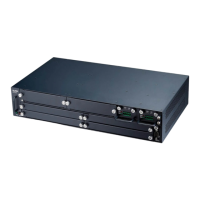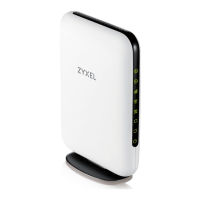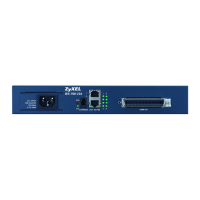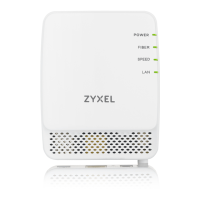Chapter 8 Basic Setting
OLT2406 User’s Guide
102
8.6 IP Setup
Use the IP Setup screen to configure the OLT IP address, default gateway device, and the management
VLAN ID. The default gateway specifies the IP address of the default gateway (next hop) for outgoing
traffic.
Management IP Addresses
The OLT needs an IP address for it to be managed over the network. 192.168.1.1 is the default in-band
management IP address and 192.168.0.1 is the default out-of-band (management port) IP address. The
subnet mask specifies the network number portion of an IP address. The factory default subnet mask is
255.255.255.0.
You can configure up to 32 IP addresses which are used to access and manage the OLT from the ports
belonging to the pre-defined VLAN(s).
Leave Timer Leave Time sets the duration of the Leave Period timer for GVRP in milliseconds. Each port has a
single Leave Period timer. Leave Time must be two times larger than Join Timer; the default is 600
milliseconds.
Leave All Timer Leave All Timer sets the duration of the Leave All Period timer for GVRP in milliseconds. Each port
has a single Leave All Period timer. Leave All Timer must be larger than Leave Timer.
Priority Queue Assignment
IEEE 802.1p defines up to eight separate traffic types by inserting a tag into a MAC-layer frame that contains bits to
define class of service. Frames without an explicit priority tag are given the default priority of the ingress port. Use
the next fields to configure the priority level-to-physical queue mapping.
The OLT has eight physical queues that you can map to the 8 priority levels. On the OLT, traffic assigned to higher
index queues gets through faster while traffic in lower index queues is dropped if the network is congested.
To map a priority level to a physical queue, select a physical queue from the drop-down menu on the right.
Priority Level (The following descriptions are based on the traffic types defined in the IEEE 802.1d standard (which
incorporates the 802.1p).
Level 7 Typically used for network control traffic such as router configuration messages.
Level 6 Typically used for voice traffic that is especially sensitive to jitter (jitter is the variations in delay).
Level 5 Typically used for video that consumes high bandwidth and is sensitive to jitter.
Level 4 Typically used for controlled load, latency-sensitive traffic such as SNA (Systems Network
Architecture) transactions.
Level 3 Typically used for “excellent effort” or better than best effort and would include important
business traffic that can tolerate some delay.
Level 2 This is for “spare bandwidth”.
Level 1 This is typically used for non-critical “background” traffic such as bulk transfers that are allowed
but that should not affect other applications and users.
Level 0 Typically used for best-effort traffic.
Apply Click Apply to save your changes to the OLT’s run-time memory. The OLT loses these changes if it
is turned off or loses power, so use the Save link on the top navigation panel to save your
changes to the non-volatile memory when you are done configuring.
Cancel Click Cancel to reset the fields.
Table 19 Basic Setting > Switch Setup (continued)
LABEL DESCRIPTION

